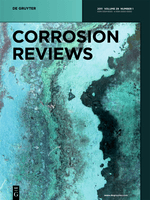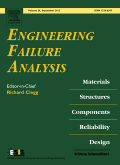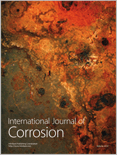
CORROSION ENGINEERING SCIENCE AND TECHNOLOGY
Scope & Guideline
Empowering research to mitigate corrosion impacts.
Introduction
Aims and Scopes
- Corrosion Mechanisms and Processes:
Investigation into the fundamental mechanisms of corrosion, including electrochemical processes, localized corrosion phenomena, and the effects of environmental factors on corrosion rates. - Corrosion Protection Techniques:
Exploration of various methodologies for corrosion prevention, such as coatings, inhibitors, and novel material formulations aimed at enhancing corrosion resistance. - Material Performance in Corrosive Environments:
Evaluation of different materials and alloys under various corrosive conditions, including their susceptibility to stress corrosion cracking, pitting, and other forms of degradation. - Innovative Experimental Techniques:
Application of advanced experimental methodologies such as electrochemical impedance spectroscopy, atomic force microscopy, and computational modeling to study corrosion behavior and predict performance. - Environmental and Ecological Considerations:
Research addressing the environmental impact of corrosion and the development of eco-friendly corrosion inhibitors and protective measures. - Multidisciplinary Approaches:
Integration of insights from materials science, chemistry, engineering, and environmental science to address corrosion issues in a holistic manner.
Trending and Emerging
- Nanotechnology in Corrosion Protection:
The use of nanomaterials and nanocoatings for enhancing corrosion resistance is gaining prominence, reflecting a broader trend towards advanced materials engineering. - Biogenic and Eco-Friendly Corrosion Inhibitors:
Research into natural and sustainable corrosion inhibitors, such as plant extracts and biopolymers, is increasing, aligning with global sustainability goals. - Advanced Corrosion Monitoring Techniques:
Development and implementation of sophisticated monitoring technologies, including real-time sensors and non-destructive testing methods, are trending to improve corrosion detection and management. - High-Entropy Alloys and New Materials:
The exploration of high-entropy alloys and other novel materials for corrosion resistance showcases a shift towards innovative material solutions in demanding environments. - Impact of Climate Change on Corrosion:
Research addressing the influence of climate change on corrosion processes, particularly in marine and industrial environments, is emerging as a significant theme. - Artificial Intelligence and Machine Learning Applications:
The application of AI and machine learning to predict corrosion behaviors and optimize corrosion protection strategies is becoming a key area of interest.
Declining or Waning
- Traditional Coating Systems:
Research on conventional coating systems may be waning as newer materials and technologies, such as nanocoatings and environmentally friendly solutions, gain traction. - Corrosion in Non-Industrial Settings:
Studies focusing on corrosion in non-industrial settings, such as rural or less polluted environments, appear to be decreasing as the focus shifts to high-impact industrial applications. - Basic Corrosion Theory:
While foundational studies are essential, the exploration of basic corrosion theories may be declining in favor of applied research that addresses specific, real-world corrosion challenges. - Corrosion in Historical Contexts:
Research on corrosion phenomena related to historical artifacts and conservation might be seeing reduced attention compared to contemporary industrial applications. - Conventional Materials Testing:
Standardized testing methods for traditional materials may be less emphasized as innovative materials and hybrid systems become the focus of research.
Similar Journals

Protection of Metals and Physical Chemistry of Surfaces
Unveiling the Chemistry Behind Metal ProtectionProtection of Metals and Physical Chemistry of Surfaces is a prominent academic journal published by MAIK NAUKA/INTERPERIODICA/SPRINGER, which provides a specialized platform for researchers and professionals in the fields of materials chemistry, metals and alloys, organic chemistry, as well as surfaces, coatings, and films. With an ISSN of 2070-2051 and an E-ISSN of 2070-206X, the journal is recognized for its rigorous peer-reviewed content and comprehensive coverage of innovative research addressing the latest advancements in material protection and surface chemistry. As of 2023, the journal has been categorized in the Q3 quartile across several relevant fields, highlighting its increasing influence within the scientific community. Although the journal is relatively niche, its open access model encourages wide dissemination of knowledge, fostering collaboration and advancements within its core disciplines. Research published in this journal plays a crucial role in not only enhancing theoretical understanding but also facilitating practical applications in various industries, thereby underlining its importance for students, researchers, and professionals alike.

Moroccan Journal of Chemistry
Exploring the Frontiers of Chemistry in Morocco and Beyond.Moroccan Journal of Chemistry, published by the University Mohammed Premier Oujda, serves as a pivotal platform for researchers and professionals in the field of chemistry, particularly focusing on diverse and emerging areas within the discipline. Established in 2018, this open-access journal facilitates widespread dissemination of scholarly articles, ensuring that cutting-edge research reaches a global audience. With an ISSN of 2351-812X and categorized in the Q3 quartile for miscellaneous chemistry in 2023, the journal maintains rigorous peer-review standards while fostering an inclusive environment for scientific dialogue. Located in Morocco, it aims to bridge local and international research communities, contributing to the advancement of knowledge in chemistry. As it continues to grow, the Moroccan Journal of Chemistry remains an essential resource for students, educators, and professionals eager to stay abreast of the latest developments in the field.

JOURNAL OF ADHESION SCIENCE AND TECHNOLOGY
Advancing the Frontiers of Adhesion Science.Journal of Adhesion Science and Technology is a distinguished publication within the fields of Chemistry, Materials Science, and Engineering, published by the reputable Taylor & Francis Ltd. Since its inception in 1987, the journal has been pivotal in advancing the understanding of adhesion mechanisms, technologies, and applications, boasting a conversion period extending to 2024. With a commendable impact factor and rankings placed in the Q2 category across various relevant domains, including Mechanics of Materials and Materials Chemistry, it offers a robust platform for scholars and practitioners alike. While currently not an open-access journal, it provides multiple access options, ensuring that vital research in adhesion science remains accessible to those dedicated to innovation and practical improvements in material interactions. This journal not only promotes empirical research but also encourages interdisciplinary collaboration, making it essential reading for researchers, industry professionals, and students eager to contribute to this dynamic field.

npj Materials Degradation
Unraveling the Secrets of Material Durabilitynpj Materials Degradation is a premier open-access journal published by NATURE PORTFOLIO that has rapidly established itself in the field of materials science since its inception in 2017. With its focus on the degradation processes affecting materials and their applications, this journal is essential for researchers and professionals seeking to advance their understanding of the longevity and sustainability of materials. The journal boasts an impressive impact, classified in the top quartile (Q1) of categories such as Ceramics and Composites, Materials Chemistry, and miscellaneous areas of Chemistry and Materials Science, as evidenced by its Scopus rankings where it ranks #17 in Chemistry (miscellaneous) and #27 in Ceramics and Composites. With open access options allowing for a broader dissemination of research findings, npj Materials Degradation serves as a vital platform for the dissemination of innovative research and interdisciplinary collaboration, enhancing the collective knowledge in the ever-evolving landscape of materials engineering and science.

CORROSION SCIENCE
Advancing the frontiers of corrosion knowledge.CORROSION SCIENCE, published by Pergamon-Elsevier Science Ltd, is a leading journal in the field of corrosion research, recognized for its significant contribution to advancing knowledge in Chemical Engineering, Chemistry, and Materials Science.
With a remarkable impact factor placing it in the Q1 category as of 2023, this journal serves as a crucial platform for researchers, engineers, and practitioners dedicated to the study of corrosion processes, prevention methods, and material degradation. Since its inception in 1961, CORROSION SCIENCE has consistently provided high-quality peer-reviewed articles that explore innovative solutions to corrosion-related challenges, fostering advancements not only in academic research but also in practical applications across various industries. The journal is based in the United Kingdom and is accessible through various academic databases, making it a vital resource for students and professionals seeking to enhance their understanding of corrosion mechanisms and mitigation strategies.

CORROSION REVIEWS
Championing Excellence in Corrosion Studies Since 1979CORROSION REVIEWS, published by WALTER DE GRUYTER GMBH in Germany, is a pivotal journal dedicated to advancing the understanding and management of corrosion phenomena across various fields including Chemical Engineering, Chemistry, and Materials Science. With an ISSN of 0334-6005 and an E-ISSN of 2191-0316, this esteemed journal has demonstrated an enduring commitment to scholarly excellence since its inception in 1979, encompassing comprehensive interdisciplinary research outputs and reviews. Ranked in the Q2 category across several disciplines for 2023, and positioned favorably in Scopus rankings—#94 in Chemical Engineering and #145 in Chemistry—it serves as an essential resource for researchers and professionals seeking to enhance their knowledge and application of corrosion science. While the journal does not currently offer open access, its rigorous peer-review process ensures high-quality, credible research publications that contribute significantly to the academic community's efforts in corrosion prevention and policy. Researchers, students, and industry professionals alike will find CORROSION REVIEWS an indispensable tool for staying at the forefront of this critical area of study.

Engineering Failure Analysis
Navigating the Complexities of Engineering FailuresEngineering Failure Analysis is a prestigious peer-reviewed journal published by PERGAMON-ELSEVIER SCIENCE LTD, dedicated to advancing the field of engineering through comprehensive investigations into the causes and consequences of failures in various engineering domains. Established in 1994, the journal has become a cornerstone of knowledge in sectors such as Aerospace, Automotive, and Materials Science, earning its place within the Q1 quartile across multiple relevant categories in 2023. With a broad scope that encompasses topics related to safety, risk, reliability, and quality, it serves as a vital resource for researchers, professionals, and students keen on understanding how to mitigate failures and improve engineering practices. Although this journal does not currently offer Open Access, its impact is underscored by its high Scopus ranking, where it sits comfortably in the 36th position out of 307 in General Engineering. By bridging theoretical insights and practical applications, Engineering Failure Analysis plays a pivotal role in shaping the future of engineering standards and safety practices.

International Journal of Corrosion
Leading the Charge Against Corrosion in EngineeringInternational Journal of Corrosion is a distinguished peer-reviewed journal published by HINDAWI LTD, focusing on the critical field of corrosion research, a vital aspect of materials science and chemical engineering. Since becoming an Open Access journal in 2010, it has provided a platform for disseminating pivotal findings related to corrosion mechanisms, prevention strategies, and innovative materials designed to counteract corrosion, thus directly impacting industries ranging from construction to energy. The journal boasts a respectable impact reflected in its Scopus rankings, holding a Q3 quartile in both Materials Science and Process Chemistry and Technology, with commendable rankings of #157 out of 463 and #37 out of 73, respectively. By fostering knowledge exchange and collaboration among researchers, professionals, and students, the International Journal of Corrosion plays an essential role in advancing the understanding of corrosion phenomena, thereby contributing significantly to the development of more resilient materials and sustainable engineering practices.

International Journal of Corrosion and Scale Inhibition
Exploring the Science Behind Corrosion and Scale InhibitionInternational Journal of Corrosion and Scale Inhibition (ISSN: 2305-6894, E-ISSN: 2305-6894), published by VSEROSSIISKAYA ASSOTSIATSIYA KORROZIONISTOV, is a distinguished open-access journal dedicated to advancing knowledge in the critical fields of corrosion science and material degradation processes. Established in 2012, this journal serves as a vital platform for researchers, professionals, and students aiming to explore innovative solutions to corrosion-related challenges across diverse industries. Located in the Russian Federation, it boasts commendable rankings, placing it in the Q2 category for both Materials Chemistry and Metals and Alloys, signifying its significant impact within the scientific community. With a robust Scopus ranking—a commendable 40th out of 176 in Materials Science for Metals and Alloys and 120th out of 317 in Materials Chemistry—the journal highlights its pivotal role in disseminating research that shapes the future of material durability and sustainability. By fostering open access to scholarly work, the journal ensures that critical findings are accessible to a broad audience, thereby promoting knowledge sharing and collaboration in the quest to mitigate corrosion and enhance material performance.

Corrosion Science and Technology-Korea
Fostering collaboration in the realm of corrosion science.Corrosion Science and Technology-Korea, published by the CORROSION SCIENCE SOC KOREA, is a pivotal journal dedicated to the exploration and advancement of knowledge in corrosion science, particularly within the context of materials performance and maintenance. Established to foster innovation and collaboration among scholars in South Korea and beyond, this journal focuses on areas such as electrochemistry, metal alloys, and surface coatings, catering to a diverse audience of researchers, professionals, and students in materials science and chemistry. Despite its current quartile rankings, including Q4 in Electrochemistry and Q3 in various materials-related categories, the journal aims to enhance its visibility and impact in the scientific community by publishing high-quality research and reviews. With its ISSN 1598-6462 and E-ISSN 2288-6524, Corrosion Science and Technology-Korea is committed to contributing to the understanding and mitigation of corrosion issues, thereby promoting sustainability and longevity in engineering applications.